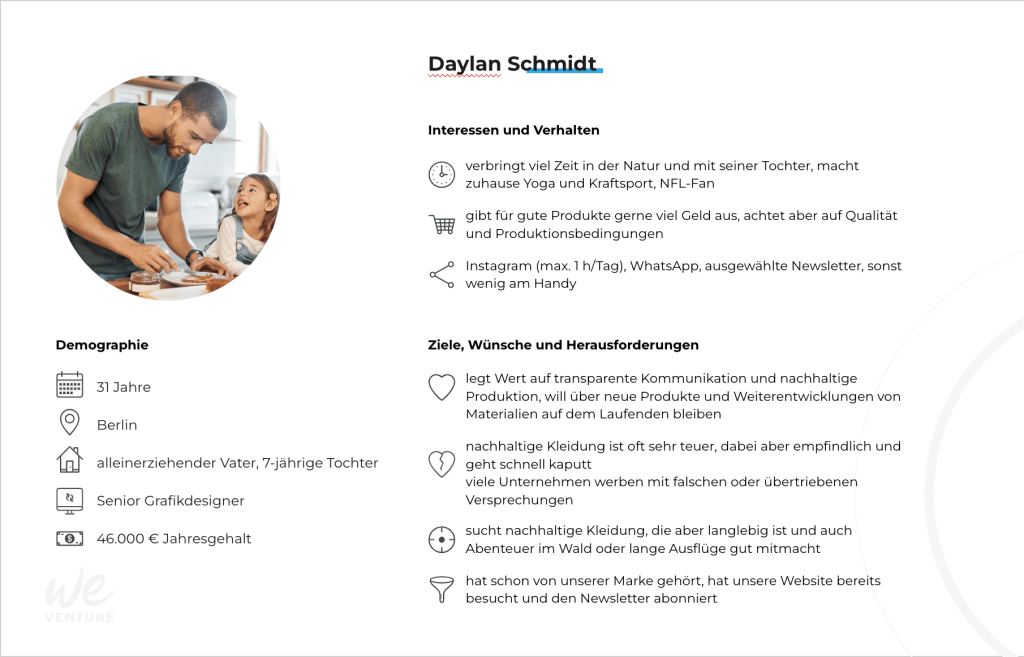

Create a buyer persona and optimise your business – this could be an advertising slogan for buyer personas. And even if it sounds a bit trite, there is some truth to this statement: with personas, you get to know your target group in a completely new way and can target your marketing activities more precisely. What exactly is a buyer persona and how do you create one? Find out here!
If you want to sell products and services successfully online, you first have to reach potential customers. So far, so clear. But how do I best reach these people? Who shops what, when and through which channels? What interests, needs and even fears do my potential customers have? What do they need, although they may not even know it yet? In short: What makes my target group tick?
We notice: Only those who know and understand their target group can communicate in a targeted manner and optimally promote their products or services. In addition to the classic target group analysis, the development of one – or, depending on requirements, several – buyer personas can be essential for the success of a company. … The development of a what?
A buyer persona is a fictional but realistic person from a target group. A good buyer persona is based on socio-demographic and psychological data as well as information around actions, media use and more. From all this information we create a person who is representative of a target group and has a name, a job, maybe a family and definitely needs, fears and desires.
A target group is a section of the overall market and usually describes all people who are potentially interested in buying a specific product or service. But no matter how much we narrow down and filter using socio-demographic and psychographic characteristics, the target group remains a faceless and very heterogeneous mass.
A buyer persona, on the other hand, is not a cross-section of people, but a single person with pain points, goals and personal characteristics. Personas are thus a further development of the target group, making it more tangible and giving it a concrete face.
A buyer persona is therefore by no means something you shake out of your sleeve at the drop of a hat. It is far too important for that.
Only those who know their customers can give them what they really want and need. This is especially important since the internet is contributing more and more to the turnover of many companies every year: there are thousands of online shops competing for customers. In order to convince potential buyers and address them with relevant information, you have to know your target group. That’s why buyer personas are a valuable tool for all areas of marketing.
We don’t create a buyer persona to make a nice-sounding profile with a few nice pictures and a stylish design and then print it out to hang in our meeting room. Although you can certainly do that. Our goal is not to do marketing for a faceless crowd. Instead, we want to ask, “What would our buyer persona Daylan Schmidt think of this newsletter? What added value does this issue have for Daylan?”
The more concrete our persona is and the better we know them, the more targeted we can tailor our marketing strategy to them. Ultimately, we can better reach our potential customers at all stages of the marketing funnel and build long-term relationships based on understanding.
So in the end only the marketing department has anything to gain from buyer personas? Far from it! If they are done well and used sensibly, all kinds of departments in the company can benefit from personas.
We now know what buyer personas are, what they can do – and that we definitely want to have some! And how do we do that? We got an overview of what information we need, where we get it from and how we proceed step by step to create a buyer persona.
Although this list is already very extensive, it is by no means complete – nor can it be. If you sell heat pumps, the size of the plot and the type of home can be decisive. If you market particularly sustainable and natural clothing, the environmental awareness of your persona can play just as big a role as the need for certain cuts or fabrics. The (socio-)demographic and psychographic data are only a framework that needs to be gradually filled with personalised and relevant information about your target group.
You can create your buyer persona for both B2C and B2B. Just make sure to gather the relevant information: for a B2C persona, marital status, private fears or hobbies are important; in B2B, working hours, role in the company or work-related concerns can have a decisive influence on the buying process.
We now know what information we need. But that was not necessarily the most difficult part of the equation. Because we learned at the beginning that we don’t just make this information up as we go along. On the contrary: it must be based on reliable data. Data that actually describes our target group. You can generate data about your target group from the following sources:
The ideal process to create a buyer persona is very extensive and can take weeks or months if you conduct interviews or research focus groups. In large companies this is often feasible both in terms of time and money, but in small or young companies these possibilities are often lacking. But don’t let that stop you! Even a few targeted interviews, a look at previous purchases or an analysis of your Facebook likes can be very revealing. Solid data is important, but you can also generate it with little effort. And finally, you can adapt your personas over time and enrich them with more information.
Buyer personas should be designed as vividly and realistically as possible. Therefore, they should not only be given a name, but also a face. After all, as a company we want to be able to put ourselves in the shoes of one or more personas and understand their priorities, attitudes and needs. So we should not only focus on the goal (the finished persona), but also on the journey (getting to know a person from our target group better).
While searching for creative names and images, don’t lose sight of the fact that your persona should be based on data and be true to reality. Always keep in mind what information will really help you. This doesn’t mean that the persona profile should only be filled with terms from your marketing department. But if you are selling heat pumps, the nutritional form of your persona might not be crucial.

You can invest a lot of time and brainpower in a good buyer persona: You have to collect and evaluate the right data and shape the whole thing into a realistic but fictitious person who is representative of a part of the target group. Wow. A complex matter. But it’s worth the effort! Buyer personas help you to fulfil the actual wishes of your potential new and existing customers – and not simply the needs that you would hope for from them. This way you can address them specifically and increase the likelihood that they will buy your product or service and remain loyal to you in the long term.